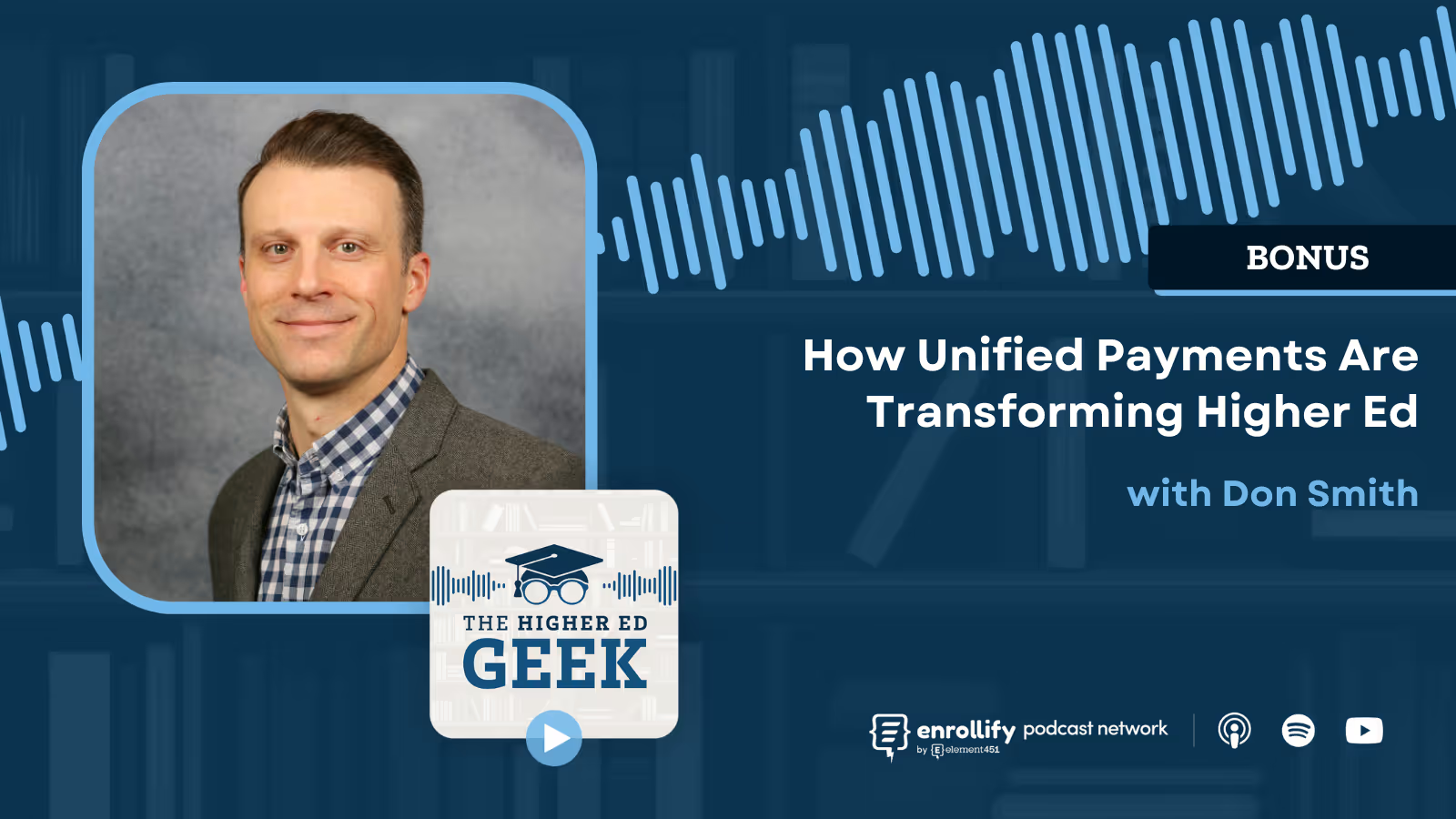About the Episode
Got a story to tell? An innovative idea to share? Fill out our guest nomination form and let's chat!
About the Episode:
In this live episode from Transact 360, we talk with Don Smith, General Manager of Integrated Payments at Transact, about the rapid evolution of student payments. Don shares insights on how unified payment systems improve the student experience, the growing demand for financial flexibility, and how institutions can remove friction from the payment process. We also explore AI, embedded finance, and the future of digital wallets on campus.
What are unified payment systems, and why are they essential in higher education?
Don Smith breaks down the concept of unified payment systems as platforms that centralize all campus payments—tuition, housing, dining, and more—into one cohesive infrastructure. This consolidation removes administrative silos, increases visibility, and allows institutions to make better data-informed decisions. With this centralization, campuses can understand not just where money flows, but also anticipate student needs and respond to financial behaviors in real-time.
Unified systems aren’t just about internal efficiency—they’re about the student experience. When payments are fragmented across multiple platforms, students may encounter confusing or inconsistent processes that increase friction and frustration. As Don puts it, every payment touchpoint is a step in the student's journey toward their educational goal. The more seamless that step is, the more likely students are to persist and succeed.
Especially post-pandemic, institutions are more open to outside partners and interoperable tools than ever before. Don notes that this paradigm shift is fueling a new kind of collaboration between vendors and universities—one focused on adaptability, speed, and student outcomes. A unified payment system is no longer a luxury—it’s foundational to a modern, responsive campus ecosystem.
Why is interoperability so crucial when choosing higher ed payment platforms?
Interoperability—the ability of a payment system to integrate smoothly with other platforms—is a non-negotiable in today’s higher ed landscape. According to Don, campus leaders are increasingly outcome-driven, and interoperability supports better outcomes by aligning technology with the student journey. When systems “talk to each other,” students experience fewer barriers, and institutions get cleaner data and a clearer picture of what’s working.
One compelling example? Embedded finance. Think mobile apps that present payment plans, financial aid options, or tuition calculators exactly when students need them. Or open banking tools that help students understand their financial health in the moment. These aren’t just fancy add-ons—they’re ways to make finance invisible and intuitive, embedded right into the student experience.
Interoperability also means flexibility. A modern payment system should work with Apple Pay, Google Pay, bank transfers, and 529 plans. But as Don points out, too much choice can be paralyzing. That’s where thoughtful UX design becomes critical—offering the right payment methods at the right time without overwhelming the user. It's all about meeting students where they are without making them feel lost in the process.
How are student payment trends shifting, especially for Gen Z?
Gen Z is reshaping how institutions approach student payments. As Don explains, this generation is both digitally native and financially cautious. Having come of age during the Great Recession and seen millennials burdened with student debt, Gen Z is deliberate and data-savvy when it comes to money. They expect mobile-friendly, flexible, and intuitive financial tools—and they’re not afraid to bounce if they hit a friction point.
That’s why payment flexibility is key. Offering installment plans, interest-free payment options, or a seamless way to use 529 savings accounts directly through digital wallets can make or break a student’s enrollment decision. Transact has seen strong adoption of these tools, including a new capability to link 529 accounts directly into payment portals—removing yet another barrier to success.
International students are also a major consideration. As institutions work to increase international student enrollment, cross-border payments and currency conversion become more vital. Payment systems need to be globally capable and locally understandable, making it easy for students around the world to pay tuition, housing, and fees without getting stuck in red tape or poor exchange rates.
What innovations and trends should higher ed leaders be watching?
Don leaves us with a powerful closing message: higher ed payment systems are in a moment of rapid experimentation, and that’s a good thing. AI in higher education is a hot topic, and while the tech is promising, it comes with ethical concerns around bias, hallucinations, and regulation. Leaders should explore AI’s potential but proceed with clear guidelines and guardrails in mind.
Other trends to watch? Blockchain and crypto—especially in cross-border payment scenarios—and the rise of open banking, which could empower students with personalized financial insights. Don sees embedded finance becoming ubiquitous, and he encourages institutions to think critically about when and how to introduce financial tools throughout a student’s journey.
Ultimately, Don champions curiosity, iteration, and partnership. No one knows exactly how this will all play out, but the institutions willing to stay plugged in, ask bold questions, and co-create solutions with partners will be the ones best positioned for the future.
About the Show: The Higher Ed Geek Podcast explores the impact of edtech on the student experience by speaking with diverse leaders from institutions, companies, and nonprofit organizations. Each week we aim to provide an engaging, fun, and relevant dose of professional development that honors the wide range of work happening all across the higher ed ecosystem. Come geek out with us! The Higher Ed Geek Podcast is hosted by Dustin Ramsdell and is a proud member of the Enrollify Podcast Network.
Connect With Our Host:
Dustin Ramsdell
About The Enrollify Podcast Network:
The Higher Ed Geek is a part of the Enrollify Podcast Network. If you like this podcast, chances are you’ll like other Enrollify shows too!
Some of our favorites include Generation AI and I Wanna Work There.
Enrollify is produced by Element451 — the next-generation AI student engagement platform helping institutions create meaningful and personalized interactions with students. Learn more at element451.com.
Attend the 2025 Engage Summit!
The Engage Summit is the premier conference for forward-thinking leaders and practitioners dedicated to exploring the transformative power of AI in education.
Explore the strategies and tools to step into the next generation of student engagement, supercharged by AI. You'll leave ready to deliver the most personalized digital engagement experience every step of the way.
👉🏻 Register now to secure your spot in Charlotte, NC, on June 24-25, 2025!















